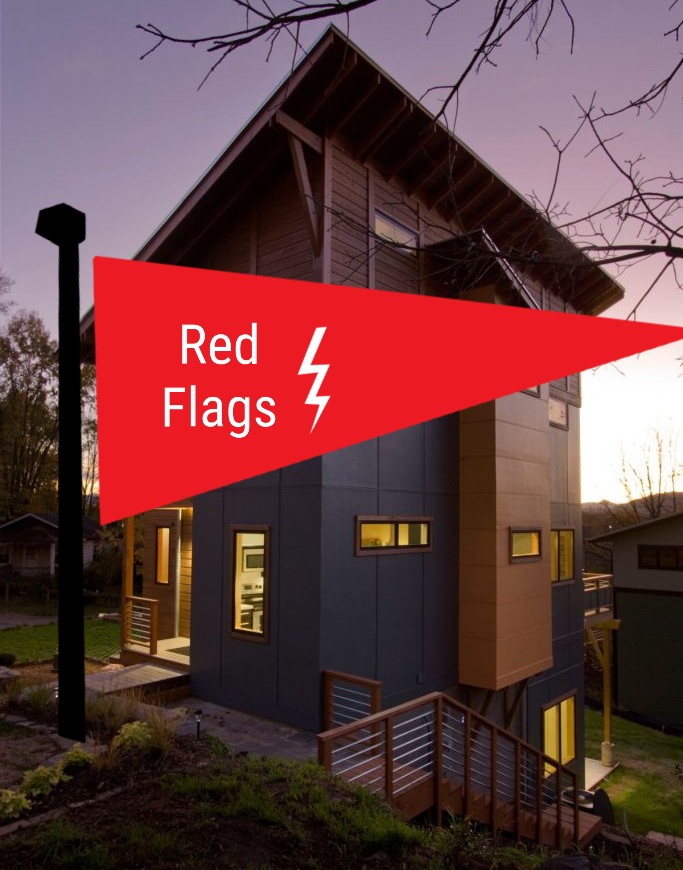Everyone is using the term red flags when it comes to relationships, but not when it comes to real estate, and believe me, there are plenty of red flags in this industry. From sellers that try to hide issues, to Realtors not disclosing key information about a home, to people robbing you of your investment. Anything is possible. This isn’t meant to be a comprehensive checklist. This is to help you catch some really easy, potential ‘deal breaker’ issues that should make you either walk away completely, perhaps run, or negotiate the price further. Just the big ones here, that could be difficult or far too expensive to fix.
Let’s start with your research at home.
Check FEMA flood maps, I don’t care if its on the side of a mountain, check, then double check.
If the shading is in red, run. Period.
Any other color, investigate further if the deal is good enough. Get a couple of flood insurance quotes.
Check Google Earth and street view. Look for major negative factors nearby like a landfill, trailer park,
etc. ‘Walk’ up and down the street virtually and see what the neighborhood looks like. These pictures
can be years out of date, but it will still give you an idea of what the area is like. Look at the neighboring
lawn care, broken down cars, people just loitering in the street, etc.
Check the GIS records (Geographic Imaging Service). Usually its on the county’s website, sometimes
you’ll get directed to QPublic or another third-party. These are pretty easy to navigate and can show
property boundaries, utilities etc.While the boundaries are not guaranteed accurate, they will at least give you an idea of potential issues like encroachments, etc., that will need a survey to be sure of.
Next, lets talk about when you go to the property.
At this point in my experience, I can generally tell from the driveway if I want the house or not.
As you get close, about a half mile out, pay close attention to the drive in. As in Street View, look at lawn
care, property up keep, vehicles, etc.
From the driveway, look at the horizontal roof line at the top. Is it relatively straight across, or does it
look like a Six Flags ride? Work your way down the roof, are there major sags? Are the ends of the
rafters exposed and rotted? These are potential big ticket repairs and need further investigation.
We aren’t concerned with general shingle wear (not for the purpose of this at least), that’s an easy one
to plug a number in for, but do check to see how many layers appear to be on the roof. One layer, you
can likely just do a ‘shingle over’. More than that and you need to plan for tear offs, which can get
expensive.
Look at the siding, are there places missing? Is the wood rotted underneath? Signs of extensive staining
from water running down and potentially inside the wall? These are structural red flags.
Move down to the foundation and scan from the front, and then standing at the end looking down
lengthwise. Any major cracks, signs of settling of even possibly the blocks ‘folding’ or turning in or out?
Underneath the house (crawlspace), is there vapor barrier? That’s the plastic covering the dirt. If not,
assume there are some moisture issues of some kind at best.
Look at the floor joists. Watch for white, yellow or black growth on them. This is a sign of extended
moisture and high humidity problems that will have to be resolved, and the mold/growth remediated.
How does it smell under there? Like a damp basement and dirt, or like sewage? Is there standing water?
Its also a good time while you’re there to inspect the general condition of the joists and sub-flooring. Are
they soft, broken or signs of rot?
Look at the foundation again for the same signs mentioned above.
What’s the plumbing (supply lines)? Make sure they aren’t gray polybutylene, which many buyer’s
lenders won’t finance, and will never survive a home inspection anyway. Those will have to go. Do you see galvanized supply piping? That is likely corroded and closed up inside, even if it looks perfect
on the outside, and will have to be replaced.
Inside the house, watch the floors for un-levelness, dips and humps. While un-level floors are common
in older homes, severe cases are a major turn off for buyers, and potential foundational red flags.
Check the electrical panel, is it breakers or screw in fuses. If its fuses, you’re looking at a minimum of a
new panel installation, and likely many other electrical upgrades as well.
Look in the attic for rotten wood, broken rafters, growth on the wood like in the crawlspace, etc.
Is the attic insulated?
Are there space heaters and/or window air conditioners? That’s a good sign the HVAC isn’t working.
That’s pretty much it. Again, this isn’t meant to be a comprehensive checklist, that’s in our other course
lessons. This is just a quick guide for major Red Flags that can be deal killers and turn a house into a
money pit fast.




